
Phragmipedium besseae Dodson & Kuhn
- Basionym: Phragmipedium besseae Dodson & Kuhn in American Orchid Society Bulletin 50: 1308 (1981)
- Type: "Peru: San Martin: on the road from Tarapoto to Yurimaguas, lithophytic on wet granite rocks in semishade, alt. 1100 m, 13 July 1981, J. Halton & E. Besse 62 (SEL)." (Dodson & Kuhn, 1981)
- Latin Diagnosis: "Species spectabilis haec P. schlimii (Linden & Rchb. f.) Rolfe similis, sed floribus cinnabarinis, petalis ovatis obtusis et staminodio obovato-subpentagono distinguitur." (Dodson & Kuhn, 1981)
- Etymology: "Named in honor of Mrs. Elizabeth Locke Besse who not only found the first plant of the species but has contributed substantially to botanical exploration in the neotropics." (Dodson & Kuhn, 1981)
- History: The first sighting of Phrag. besseae was in the 1960s by Father Angel Andreetta, "at some distance and on the other side of the Rio Cuyes in southeastern Ecuador, but thought they were Begonia froebelii." (Dodson 1992) The plant was recognized as a new species when discovered by Libby Besse while leading a 1981 expedition to Peru for the Marie Selby Botanical Gardens. She found it while exploring alongside a road between Tarapoto and Yurimaguas. In 1984 a second population was discovered by C.H. Dodson and his wife beside the dam at Guarumales near Paute in Ecuador. In 1985 Dennis D'Alessandro discovered a third population upriver from Zamora in southern Ecuador. This population, "Instead of having bright, dark red flowers with the petals acute and held stiffly outward, plants of the Zamora population have more yellow in the flowers, and the petals are obtuse at the apex and hang downward a bit. The inflorescences are shorter and more compact and the plants are much easier to cultivate than those of the other populations." (Dodson 1992) This form has become known as either Phrag. dalessandroi or Phrag. besseae var. dalessandroi. Stig Dalstrom subsequently found populations of the original form at three more sites in Ecuador. It can be assumed that more populations in Peru and Ecuador have been discovered and many more remain undiscovered thanks to the sheer nature of the plants' canyon habitat.
- Varieties & Forms:
Phragmipedium besseae var. dalessandroi (Dodson & Gruss in Die Orchidee 47(4): 216 (1996)) Moon & Cribb in Orchid Review, 105(1216): 227-230 (1997) - morphological variant
Phragmipedium besseae fma. flavum (Braem in Schlechteriana 1(2): 55 (1990)) Gruss in Caesiana 12: 65 (1999) - albino form
- Synonyms: none
- Chromosome Count -
| 2n = |
metacentrics |
telocentrics |
n.f. |
| 26 |
10 |
16 |
36 |
Plant Habit
- Leaves: 13-30 cm long, 2-5 cm wide, dull green, keeled
- Inflorescence: 1-6 flowered, opening sequentially, up to 50 cm long, brown, pilose
- Bloom: 6-9 cm wide, pouch with translucent windows
var. besseae









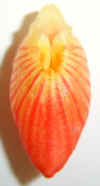
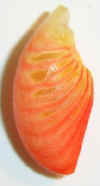
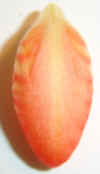
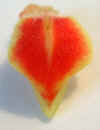
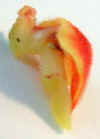
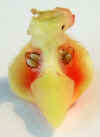
var. dalessandroi




- Plant:
var. besseae
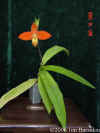
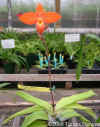

var. dalessandroi
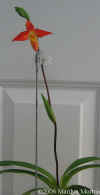


Habitat Data
- Distribution -
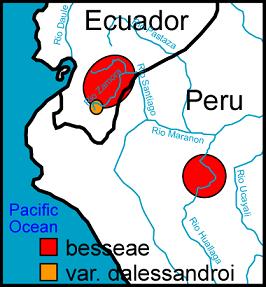
- Elevation: 1400-1800 m
- Peak Flowering in the Wild: ?
- Ecology: steep cliff faces of volcanic rock near rivers
from Paute, Ecuador:




from Chigllinda, Ecuador:






- Mean Temperature Range: 17-20°C
- Light: moderate shade
- Medium: thin mats of moss and leaf litter
- Water: constant moisture
Notes
- The plants from the first collection were notably smaller than subsequently collected specimens. This is reflected in the measurements provided in the original description by Dodson & Kuhn (1981).
- "Superior line-bred plants raised from seed are now widely available in trade and the species has recovered in the wild so that plants can now be seen at eye-level by roads in its native habitats in southern Ecuador and northern Peru." (Cribb 2004)
Sources:
- Cribb, P.J. "Phragmipedium kovachii - An Amazing Discovery and Highly Threatened Orchid." Orchid Conservation News 4 (May 2004): 19-20.
- Dodson, C.H. "Phragmipedium besseae, Discovery of the Species." American Orchid Society Bulletin 61, no. 12 (Dec 1992): 1214-18.
- Dodson, C.H., and J. Kuhn. "Phragmipedium besseae - A New Species from Peru." American Orchid Society Bulletin 50, no. 11 (Nov 1981): 1308-10.
- Gum, A. "Phragmipedium besseae, Its Role in Hybridizing." American Orchid Society Bulletin 61, no. 12 (Dec 1992): 1220-25.
- Hegedus, L.S., and F.R. Stermitz. "Further Facts on Phragmipedium besseae." American Orchid Society Bulletin 55, no. 4 (Apr 1986): 367-69.
- Karasawa, K. "Karyomorphological Observations on Phragmipedium besseae Dodson & Khun, Orchidaceae." Bulletin of the Hiroshima Botanical Garden 10 (1988): 47-50.
- McCook, Lucile M. "Systematics of Phragmipedium (Cypripedioideae; Orchidaceae)," Ph.D. dissertation, Cornell University, 1989.
- McCook, Lucile M. "An Annotated Checklist of the Genus Phragmipedium." Orchid Digest special publication (1998): 1-12.
Primary Hybrids
| Phrag. besseae x |
Hybrid |
| boissierianum |
Lutz Röllke |
| caricinum |
Mary Bess |
| caudatum |
Ruby Slippers |
| czerwiakowianum |
Robert Palm |
| dalessandroi |
Jersey |
| ecuadorense |
Ecua-Bess |
| fischeri |
Barbara LeAnn |
| hirtzii |
Mountain Maid |
| kaieteurum |
Rosalie Dixler |
| klotzscheanum |
Will Chantry |
| lindleyanum |
Andean Fire |
| longifolium |
Eric Young |
| pearcei |
Olaf Gruss |
| richteri |
Franz Glanz |
| sargentianum |
Memoria Dick Clements |
| schlimii |
Hanne Popow |
| vittatum |
Vittabess |
| wallisii |
Maria Glanz |
| warscewiczianum |
Super Rubies |
Primary Hybrids - registered as Phrag. dalessandroi
| Phrag. dalessandroi x |
Hybrid |
| besseae |
Jersey |
| caricinum |
Mont Cambrai |
| caudatum |
Point Des Pas |
| longifolium |
Nicholle Tower |
| pearcei |
Petit Anquette |
| richteri |
Olaf |
| sargentianum |
Grosnez |
| schlimii |
Seymour Tower |
| wallisii |
Paternoster |
Return to the Data Sheets Page
Page Created By: Stephen Manza
Last Updated: 11-22-06
contact: silence882@gmail.com



flavum.jpg)



































